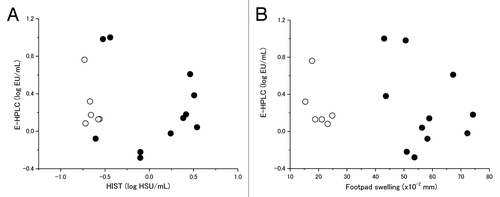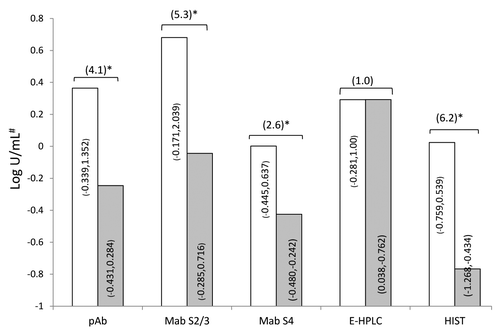Figures & data
Figure 1. Change in annual mean residual HS activity of DTaP batches and local reactions to the booster dose with DTd. Annual geometric means of HS activity (●) of DTaP batches used for primary immunization were determined shortly after them being manufactured. Detoxification processes for aP antigens were revised from the mid-1980s without changing other specifications for DTaP. Local reactions following DTd booster in adolescents at the age of 11–12 y* were monitored from 1992 to 2000 in cohorts from Hisayama-cho, Fukuoka, Japan.Citation13 The number of adolescents (in brackets) who received the booster in these cohorts from 1992 to 2000 were 1992 (368), 1993 (986), 1994 (1170), 1995 (175), 1996 (150), 1997 (56), 1998 (310), 1999 (313), and 2000 (146). (△) is the percentage of local reaction incidence at the injection sites determined by size of area of redness of ≥5 cm in diameter observed 2 d after the booster; *The vaccination program in Japan was temporarily suspended due to 2 cases of severe adverse events after DTwP vaccination in 1975 and resumed 3 mo later to start at 2 y of age until revision of the immunization schedule in 1994 to start at 3 mo of age. Therefore all children in this surveillance study were immunized with DTaP at 2 y of age with the subsequent 3 doses at 3 to 8 wk intervals with an additional dose 12 to 18 mo later (primary immunization).

Figure 2. Relationship of residual enzymatic activity of S1 as measured by E-HPLC to (A) HIST and (B) sensitizing activity to mouse foot swelling (MFS) to Dd booster. Vaccine produced after 1990 differ to those before 1990 only in strengthened detoxification procedure for aP antigens and no change was made to other specifications. (●) DTaP (n = 11) produced before 1990; (○) DTaP (n = 6) produced after 1990.

Figure 3. Comparison of carbohydrate binding, enzymatic and HS activities in DTaP made before (open bar, n = 11) and after (gray bar, n = 17) 1990. Values inside the bars represent the lowest and highest activities. Bracketed numbers outside of bars represent fold difference between before and after 1990. *Indicate statistically significant at 5% level. # log binding activity unit (BU/mL) for pAb, Mab S2&3, and Mab S4 binding assay; log enzymatic activity unit (EU/mL) for E-HPLC assay and log HSU/mL for HIST (see Methods Section).

Figure 4. Relationships between sensitizing activity to footpad swelling and B-subunit carbohydrate binding activities to fetuin ligand detected using various antibodies: (A) pAb, (B) Mab S2&3, and (C) Mab S4. (●) DTaP (n = 11) produced before 1990; (○) DTaP (n = 6) produced after 1990 which differ from those produced before 1990 only in strengthened detoxification procedure for aP antigens. *Outlier (see Statistical analysis section under Materials and Methods).

